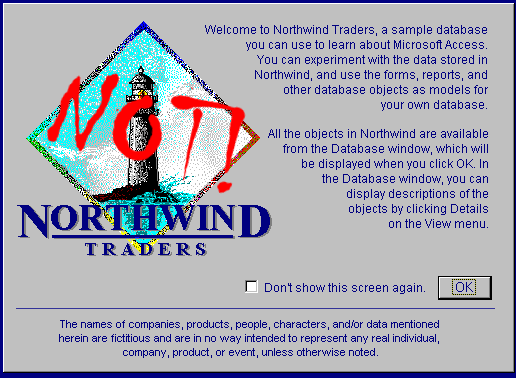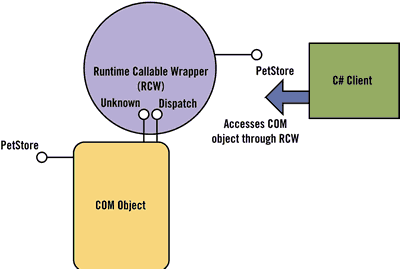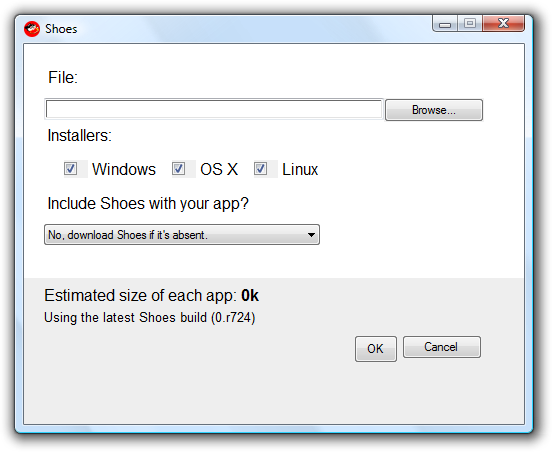NotNorthwind - Update #1 - All Your Northwind Are Belong To Us
 I posted a little rant against the Northwind Database a few weeks back, and suggested that we, the community, create a better demo database than Northwind. I proposed the name NotNorthwind.
I posted a little rant against the Northwind Database a few weeks back, and suggested that we, the community, create a better demo database than Northwind. I proposed the name NotNorthwind.
There were some varied and interesting responses.
From Scott Mitchell:
Yes, it is far from perfect and could use some updating with regards to the date/time values and the category pictures, but those warts aside, it does a good job at what it was designed to do.
From Brian Sullivan:
I feel the same way. I have to stifle a groan whenever I hear the word "Northwind" come out of presenter's mouth. I've even jokingly said that Microsoft ought to have an internal metric for new technologies called "TTN", "Time to Northwind." In mathematical terms:
Product Coolness = 1 / TTN
From Duncan Smart:
We don't a need a new one! Pubs FTW! :-)
Steven Smith says Whither Northwind?
Enter NorthWind, the HTTP standard of databases, understood by virtually all Microsoft developers without need for preamble. It just works. With the words, "I'm using Northwind for my database." I now have the complete understanding of 95% of the people in the room - we're all on the same page - and I can continue with the actual point of the presentation or demo, which is not, has not, and probably will never be, "why this database isn't Northwind."
And Jeff Atwood from Twitter ;)
@shanselman rejects the standard MSFT Northwind database. What next? "Hello World" isn't good enough for you? Snob!
There were also a lot of great comments and ongoing discussion the CodePlex site's Discussions tab and project comments. We brainstormed alternative domains like Medical, Insurance, Media, and many others. Others suggested that AdventureWorks was a fine replacement.
ASIDE: Some folks suggested just updating the dates in Northwind to the present, but as attractive as the idea of adding ELEVEN YEARS to these columns is, I just didn't feel like doing this (Thanks to the folks on Twitter for their ideas, though!).
use Northwind
update Employees set BirthDate = dateadd(yy, 11, BirthDate)
update Employees set HireDate = dateadd(yy, 11, HireDate)
update Orders set OrderDate = dateadd(yy, 11, OrderDate)
update Orders set ShippedDate = dateadd(yy, 11, ShippedDate)
update Orders set RequiredDate = dateadd(yy, 11, RequiredDate)
We had a SkypeCast call today at noon and it was agreed that Northwind does have some redeeming qualities. It's simple, it works, it's understood and there's a pile of demos written against it. We rethought the requirements.
As a small group, we've decided to extend Northwind. We'll still call it NotNorthwind (although Super Northwind 2000 and "Microsoft Visual Northwind Enabler SP2 RC0 Beta1 July Refresh Plus Pack" were also possibilities), though, but we want to add a bunch of features that should make it a more interesting database for demos/prototyping/experimenting.
It's worth pointing out that I (and we) are not interested in showcasing the shiniest, latest new thing in SQL2008 with this small effort. We're just trying to have a little fun, while updating a very old database with some interesting and fun features in the hopes that our demos/prototypes/experiments/whatever that use Northwind could possibly become more interesting.
- Product Reviews and Ratings
- This new area should introduce a number of interesting, but easily understood concepts that can be used to showcase everything from whatever cool AJAX toolkit you're demoing to how flexible your CodeGenerator or ORM is.
- Perhaps extending reviews to "x people found this review helpful" as well. Also, wish-lists, etc.
- Tagging
- In parallel to, and juxtaposed against the existing Product/Category relationship, tagging, and social tagging, introduces some interesting DB issues as we'll want to tag anything not just products, resulting in a many-to-many heterogeneous situation. It also makes for some potentially interesting User Interfaces.
- Compatibility
- We're going to pretend that the existing database can't be changed, but only extended. This way folks with existing Northwind Demos will "just work" against NotNorthwind. This plug-ability should also encourage people with demos to extend their existing those of things like web frameworks but are just using the database as a place to find scenarios.
- We'd like it to support (either via creative SQL or multiple versions) multiple databases like mysql, SQLite, Oracle, etc.
- We'd like it to be an existing "legacy" database that ORM tools could each build on top of so we could compare apples to apples.
- Sample Data
- At some point it'd be cool to make the database REALLY HUGE to test the scale of both it, and the things folks build on top of it.
- We'd like pluggable Sample Data, so we'll make the structure file separate from the sample data. Basically Database "Themes" as not everyone wants the standard Microsoft "scrubbed" names.
- Alternate Domains
- We also think that the Northwind world could be explored with more "Vertical" things like these. These could also be done without changing the core database.
- Expense Tracking and Approval
- Accounts Receivable and Payable and Payroll
- Business Intelligence - Warehousing, Sales, Trends
That's about it. I'll update the Issue Trackers and we'll try another SkypeCast same time next Thursday around noon. I'll announce the SkypeCast URL on Twitter. (AYNABTU)
About Scott
Scott Hanselman is a former professor, former Chief Architect in finance, now speaker, consultant, father, diabetic, and Microsoft employee. He is a failed stand-up comic, a cornrower, and a book author.
About Newsletter




_thumb.png)

 My
My 

 My
My